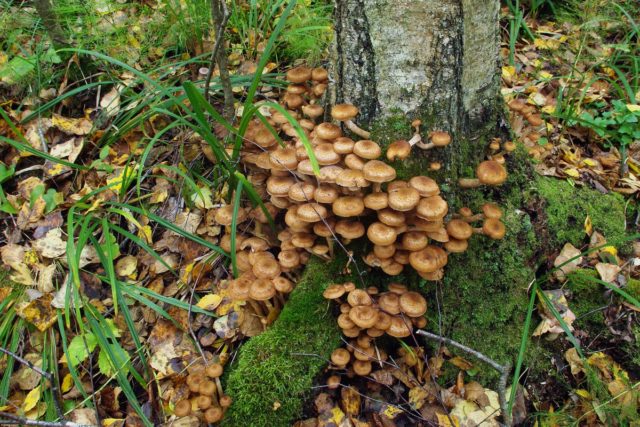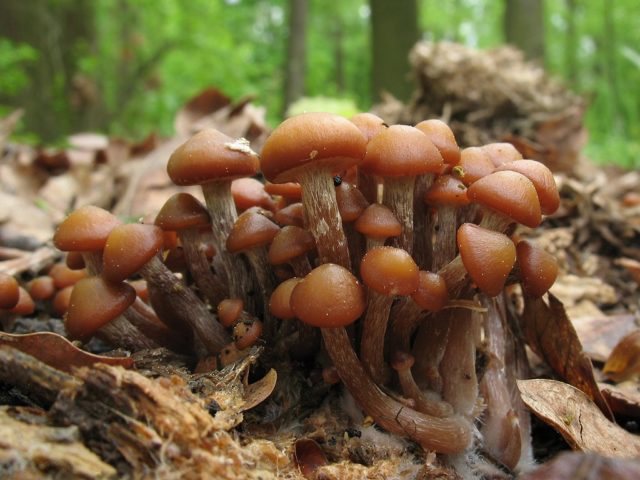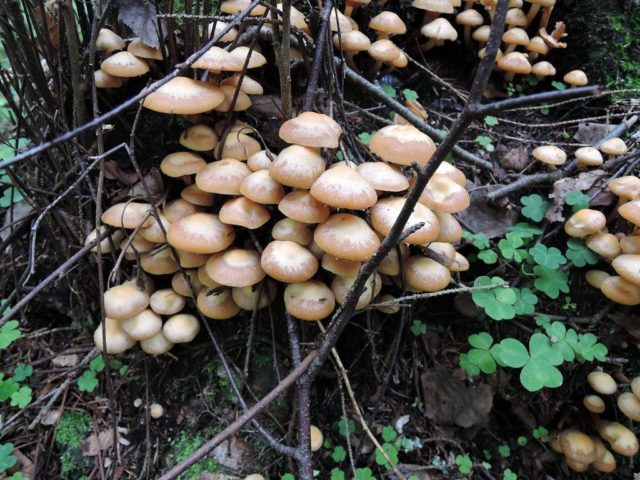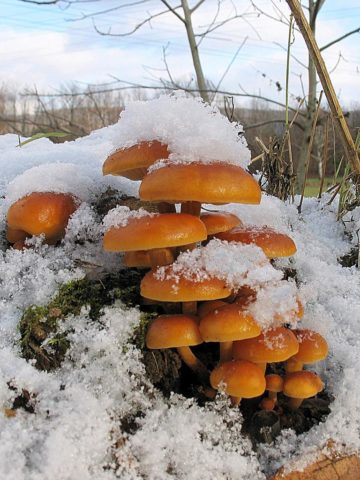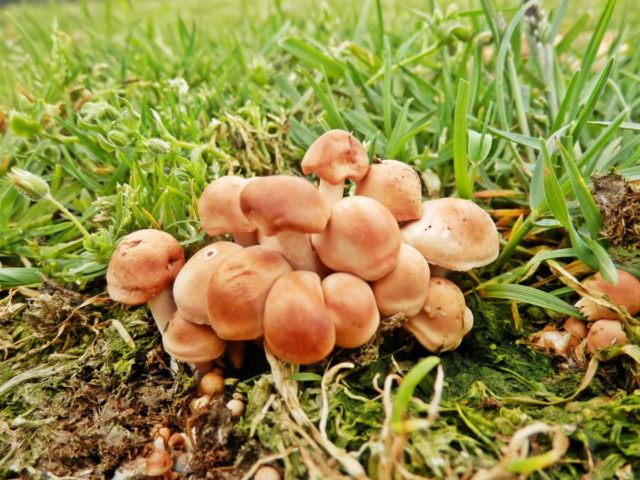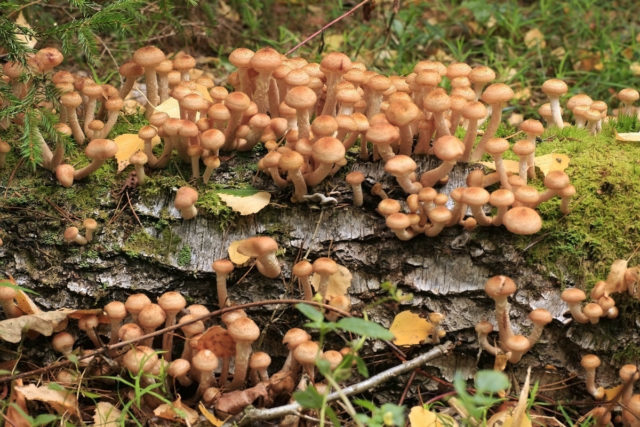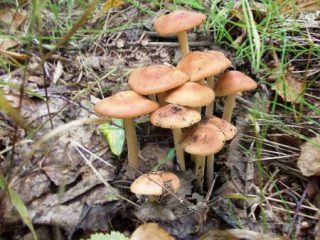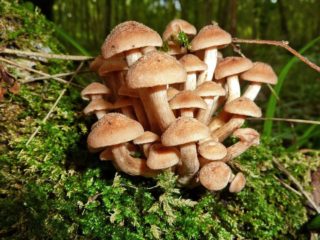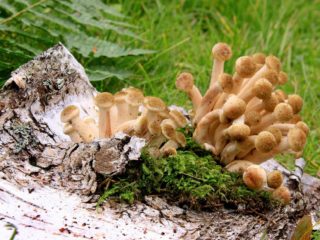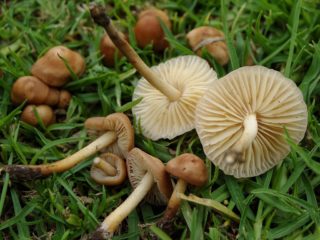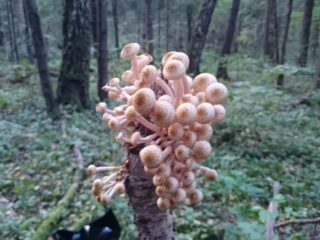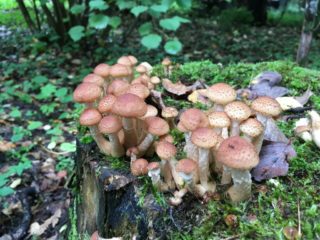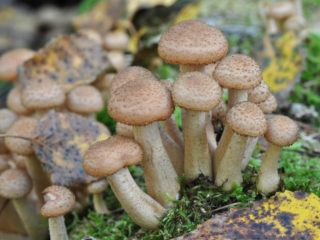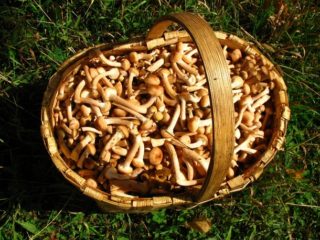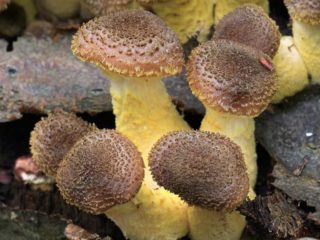Content
Honey mushrooms in the Voronezh region are distributed throughout the forest areas where oaks and birches are found. Mushrooms grow only on old weakened trees, dead wood or stumps. The species exists in a humid environment of mixed forests.
What types of edible honey mushrooms grow in Voronezh and the region
The weather conditions and ecological system of the Voronezh region fully meet the biological needs of honey mushrooms. The spread of forests, protected areas, the mixture of tree species - all these factors are favorable for the growth of mushrooms from early spring to winter.
In the Voronezh region there are more than 200 species of mushrooms with high nutritional value and conditionally edible. Honey mushrooms are distinguished by the time of fruiting and the place of growth.
Spring - grow in deciduous areas near oaks, aspens, and less often pine trees. They appear in May, after above-zero temperatures have set in. A popular species among mushroom pickers is the wood-loving collibia. Honey fungus with light flesh and a light brown cap has a pale spot in the center.
The most popular and widespread are summer ones. The color of the mushroom is brownish or dark yellow. They grow on birch remains or stumps.
Fruit bodies without a distinct odor with a pleasant taste. Appear in July, after heavy rains. The harvest season is short, the fruit body reaches biological ripeness in 3 days.
Autumn honey mushrooms (pictured) have been collected in Voronezh since late summer.
They grow on all types of wood in large groups. Externally, the fruit body is small in size and light brown in color. The cone-shaped cap is densely covered with small scales.
Winter honey mushrooms (pictured below) in the Voronezh region are collected from October to spring.
A variety with a pleasant fruity aroma and pronounced mushroom taste. A rounded cap with a mucous surface of a dark orange color. This is the only mushroom that bears fruit in winter, so it has no false doubles.
Meadows are the largest representatives of the species; they grow in groups, forming a semicircle or long rows.
Fruiting lasts for a long time - from spring to autumn. They are found in clearings, meadows, pastures, and on roadsides. Fruiting is abundant only in open areas and moist, fertile soil.
Where honey mushrooms grow in the Voronezh region
The main concentration of the species is observed in oak groves and mixed forests.Large areas of forested areas in the Voronezh region are used in the woodworking industry. After the commercial timber is removed, dead wood, stumps and illiquid remains remain. This is an ideal place for the growth of honey mushrooms of any season, except meadow ones. The latter can be found just outside the city, near small ponds and rivers, in meadows among short grass.
Where are honey mushrooms collected near Voronezh?
In the suburban areas of Voronezh, you can collect honey mushrooms in several directions, a general overview of areas and settlements popular with mushroom pickers:
- Semiluksky district, the closest to the city. There is a pine forest and partially mixed tree species here. The main direction is to the villages of Orlov Log, Fedorovka and Malaya Pokrovka.
- One of the largest mushroom places is forests and clearings near Somovo station. To collect meadow mushrooms, choose the northern direction from the station, for other varieties - the eastern direction.
- Near the settlements of Sinitsino, Shuberskoye, Orlovo, Dubovka.
- Nizhnedevitsky district, Andreevka village at Kastornoye station.
- Ramonsky district is the main distribution of meadow representatives near the villages of Yamnoye and Medovka.
- For forest specimens they go to the forests of Novaya Usman.
You can also harvest a good harvest in the Voronezh region in the area of the Leather Cordon and Lake Maklyuk.
Forest areas where honey mushrooms grow in Voronezh and the Voronezh region
The main gathering places where autumn and winter honey mushrooms grow en masse in Voronezh:
- Usmansky pine forest;
- Tellerman Grove;
- Shipov forest;
- Chalk forest;
- Long Forest;
- Khrenovsky pine forest.
On the territory of the Voronezh region there are several nature reserves where the collection of honey mushrooms is allowed in unlimited quantities and forestry enterprises that are famous for the productivity of the species.
Forestries and reserves of the Voronezh region, where you can collect honey mushrooms
The main distribution area of honey mushrooms is in the Voronezh region:
- Khopersky Reserve. Located in the east of the region on the Khoper River, the forest consists of mixed species of trees and shrubs.
- Shipova oak grove, on the Osered River, Voronezh region.
- The Kamennaya Steppe nature reserve is located in the watershed of the Chigly, Elani, and Bityuga rivers.
- Somovskoe forestry is a protected area, so travel by personal transport is prohibited.
- Novousmanskoye forestry is located in the Khokholsky district.
- Semilukskoye forestry, a large accumulation of honey mushrooms in the Ramonsky district.
A popular place among mushroom pickers for collecting honey mushrooms in the Voronezh region is the Left Bank forestry area, located on the territory of the Leather cordon.
Do honey mushrooms grow in the Grafsky Nature Reserve?
The Grafsky Reserve is located in the south of the Voronezh Biosphere Reserve. The state-protected area is rich in numerous species of mushrooms. The land is well-groomed, there is no accumulation of dead wood and stumps. Honey mushrooms grow near the village of Krasnolesny, not far from the Grafskaya railway station.
When honey mushrooms grow in Voronezh
The honey mushroom harvest continues throughout the year, with each species bearing fruit at a certain time. Spring is replaced by summer, then autumn and winter. The taste qualities of all representatives of the genus, except for wood-loving collibia, are not particularly different and the processing methods are also the same.
When can you collect spring honey mushrooms in the Voronezh region?
Spring honey fungus is not particularly in demand among mushroom pickers; many mistakenly classify it as an inedible species. Collibia is quite suitable for consumption; it grows on moss or leaf cushions in oak forests. Appears from late April or early May, depending on weather conditions.The first fruiting bodies can be found at a temperature of +7 0C, after heavy rains.
When does the collection of summer honey mushrooms begin in Voronezh and the region?
The summer species is the most fertile. In a small area, you can harvest up to three buckets of crops in a short time. The mushroom settles mainly near aspen or birch trees. In warm weather, the first families can be found in June; the main fruiting occurs in July and continues until the first frost.
When can you collect autumn honey mushrooms in the Voronezh region in 2024?
The autumn representative does not bear fruit abundantly every year; this depends on the climatic conditions of the region and the biological characteristics of the species. Mushroom picking begins at the end of the last month of summer, when the temperature drops and seasonal rains begin. Autumn honey mushrooms are collected in Voronezh before the first frost.
Winter mushroom collection season in Voronezh in 2024
Winter specimens appear at the moment when the mushroom season is completely over. Mushrooms grow quite high from the ground on the trunks of old trees. The first harvest is harvested in November. The biological cycle continues until the air temperature drops to -100C. Fruiting bodies are 80% water; when frozen, their growth stops, but their nutritional value is completely preserved. At the first thaw, in the Voronezh region this is around the end of February, they begin to grow again.
Collection rules
A special feature of mushrooms is the ability to absorb and accumulate in the fruiting body not only useful substances, but also chemical compounds harmful to health. Do not harvest near highways with active traffic; areas adjacent to industrial enterprises and city landfills are not suitable for “silent hunting”, since the chemical composition may contain heavy metals.Overripe fruiting bodies are not suitable for consumption due to the fact that the protein releases toxins during decomposition.
How to find out if honey mushrooms have appeared in Voronezh
Autumn representatives are not much better in taste, but they are superior to summer ones. If it’s a mushroom year, you can take a good harvest, which will be enough for winter harvesting. A sign that honey mushrooms have started growing in the Voronezh region will be their appearance in local markets. Mushrooms begin to grow after the long August rains. If the weather is warm, then after about 10 days the first specimens will appear, and a week later the massive growth of colonies will begin.
Conclusion
Honey mushrooms in the Voronezh region are not only raw materials for home processing, but also a good income. They collect mushrooms in oak forests, mixed forests, on old trees fallen by the wind, stumps, and wood debris. They bear fruit from May to February, each representative of the genus grows at a certain time of the year and is suitable for any method of processing.
